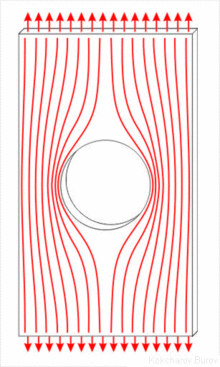Stress concentration
This article includes a list of references, related reading, or external links, but its sources remain unclear because it lacks inline citations. (February 2008) |

A stress concentration (often called stress raisers or stress risers) is a location in an object where stress is concentrated. An object is strongest when force is evenly distributed over its area, so a reduction in area, e.g. caused by a crack, results in a localized increase in stress. A material can fail, via a propagating crack, when a concentrated stress exceeds the material's theoretical cohesive strength. The real fracture strength of a material is always lower than the theoretical value because most materials contain small cracks that concentrate stress. Fatigue cracks always start at stress raisers, so removing such defects increases the fatigue strength.
Causes

Geometric discontinuities cause an object to experience a local increase in the intensity of a stress field. The examples of shapes that cause these concentrations are: cracks, sharp corners, holes and, changes in the cross-sectional area of the object. High local stresses can cause the object to fail more quickly than if it wasn't there. Engineers must design the geometry to minimize stress concentrations.
Prevention
A counter-intuitive method of reducing one of the worst types of stress concentrations, a crack, is to drill a large hole at the end of the crack. The drilled hole, with its relatively large diameter, causes a smaller stress concentration than the sharp end of a crack. This is however, a temporary solution that must be corrected at the first opportune time.
It is important to systematically check for possible stress concentrations caused by cracks -- there is a critical crack length of 2a for which, when this value is exceeded, the crack proceeds to definite catastrophic failure. This ultimate failure is definite since the crack will propagate on its own once the length is greater than 2a. (There is no additional energy required to increase the crack length so the crack will continue to enlarge until the material fails.) The origins of the value 2a can be understood through Griffith's theory of brittle fracture.
Examples

The term "stress raiser" is used in orthopedics; a focus point of stress on an implanted orthosis is very likely to be its point of failure.
Classic cases of metal failures due to stress concentrations include metal fatigue at the corners of the windows of the De Havilland Comet aircraft and brittle fractures at the corners of hatches in Liberty ships in cold and stressful conditions in winter storms in the Atlantic Ocean.
Concentration factor
The maximum stress felt near a crack occurs in the area of lowest radius of curvature. In an elliptical crack of length and width , under an applied external stress , the stress at the ends of the major axes is given by:
where ρ is the radius of curvature of the crack tip. A stress concentration factor is the ratio of the highest stress () to a reference stress () of the gross cross-section. As the radius of curvature approaches zero, the maximum stress approaches infinity. Note that the stress concentration factor is a function of the geometry of a crack, and not of its size. These factors can be found in typical engineering reference materials to predict the stresses that could otherwise not be analyzed using strength of materials approaches. This is not to be confused with 'Stress Intensity Factor'.
Concentration factor calculation
There are two ways to calculate stress concentration factor. One of them is to use finite element method and the other is theoretical value which can be calculated from the equation above. There can be a difference with both calculated value. While using a FEM program, the obtained value is more accurate. This difference may result from the reason that the program is more sensitive in division of elements. In other words, the difference is probably due to the ability of element analysis of the program.
Yet another way to calculate stress concentration factor is through photoelastic stress analysis. This involves mounting the specimen on a photoelastic bench consisting of a polariser, two quarter plates and an analyser. The specimen is loaded perpendicular to the axis of the bench, and from slope of load vs fringe order curve, the stress concentration factor can be calculated. However this method suffers from several optical constraints.
See also
References
- ESDU64001: Guide to stress concentration data (ISBN 1-86246-279-8)
- Pilkey, Walter D, Peterson's Stress Concentraton Factors, Wiley, 2nd Ed (1999). ISBN 0-471-53849-3
- ASME Professional Development Series - 100 Questions On...





